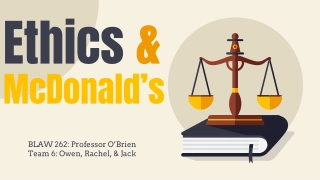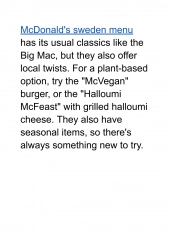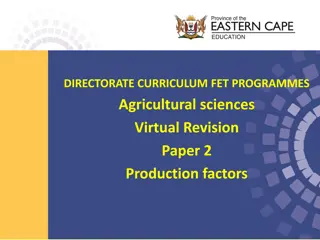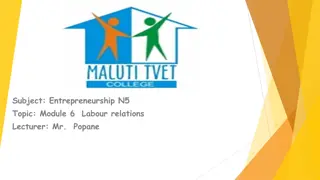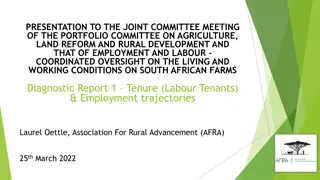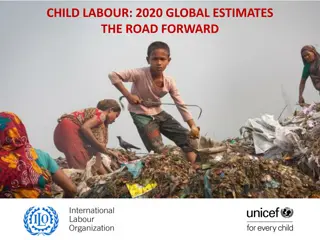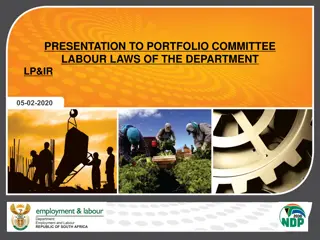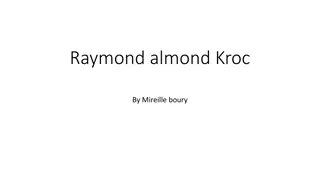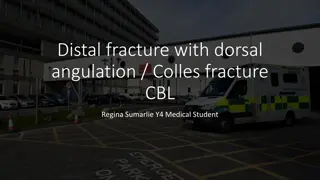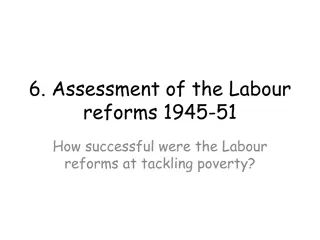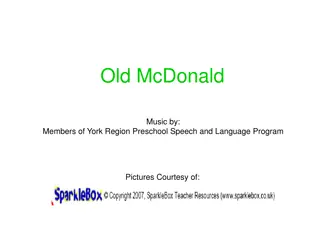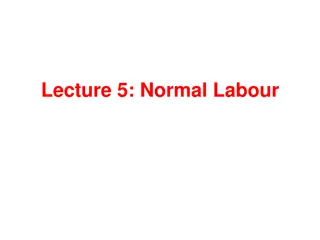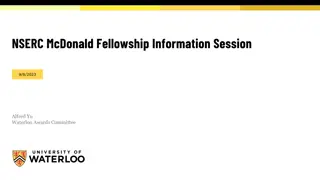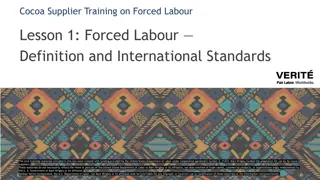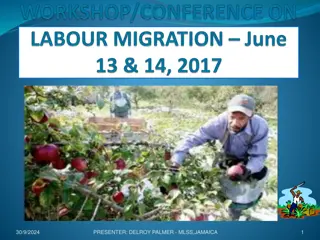McDonald's Fined for Exploiting Child Labour in the UK
An investigation reveals that a McDonald's restaurant in the UK has been fined for illegally employing school-aged children, making them work overtime. The violation highlights the issue of child exploitation in the workforce.
Download Presentation

Please find below an Image/Link to download the presentation.
The content on the website is provided AS IS for your information and personal use only. It may not be sold, licensed, or shared on other websites without obtaining consent from the author.If you encounter any issues during the download, it is possible that the publisher has removed the file from their server.
You are allowed to download the files provided on this website for personal or commercial use, subject to the condition that they are used lawfully. All files are the property of their respective owners.
The content on the website is provided AS IS for your information and personal use only. It may not be sold, licensed, or shared on other websites without obtaining consent from the author.
E N D
Presentation Transcript
Paper 2 Writers viewpoints and perspectives 1h 45 (incl 15 minutes reading time)
Timings and marks SECTION A Question Q1: Choose 4 true statements Marks (4) Writing Time 5 minutes Q2 Source A+ B: Summarise similarities/differences (8) 9 minutes Q3 Source B - How does X use language to (12) 13 minutes Q4 Source A + B Compare how the 2 writers (16) 18 minutes SECTION B Question Q5 creative writing 40 marks for writing (25% of total GCSE) 24 (AO5 content)+16 (AO6 SPaG) marks 45 minutes
Section A Structure TWO linked sources from diff. time periods & genres Sources = 19thC & EITHER 20thOR 21stCs Genre of sources: non-fiction and literary non-fiction AO1 Identify and interpret explicit and implicit information and ideas. Select and synthesise evidence from different texts. AO2 Explain, comment on and analyse how writers use language and structure to achieve effects and influence readers, using relevant subject terminology to support their views. Compare writers ideas and perspectives, as well as how these are conveyed, across two or more texts. Evaluate texts critically and support this with appropriate textual references. (ONLY ON PAPER 1) AO3 AO4
Section B Structure Homework has no value. Some students get it done for them; some don t do it at all. Students should be relaxing in their free time. Write an article for a broadsheet newspaper in which you explain your point of view on this statement. AO5 Communicate clearly, effectively and imaginatively, selecting and adapting tone, style and register for different forms, purposes and audiences. Organise information and ideas, using structural and grammatical features to support coherence and cohesion of texts. Students must use a range of vocabulary and sentence structures for clarity, purpose and effect, with accurate spelling and punctuation. (This requirement must constitute 20% of the marks for each specification as a whole). AO6
KEY VOCABULARY Explicit: directly expressed Implicit: suggested though not directly expressed Synthesise: to make meaning of something Question 1: 4 marks Read again Source A from lines 1 to 12. Choose four statements below which are TRUE. Shade the boxes of the ones that you think are true Choose a maximum of four statements. AO1 Identify and interpret explicit and implicit information and ideas. Select and synthesise evidence from different texts.
Example McDonald's fined for exploiting child labour An investigation shows that school-aged children are being exploited, even in the UK. A McDonald s restaurant has been fined more than 12,000 for employing schoolchildren illegally, forcing them to work overtime and late on school nights. A franchise of the fast-food restaurant in Camberley, Surrey, was found guilty of working teenagers late into the night on school days, often without rest breaks. Child employment officers from Surrey county council found more than 50 breaches of the law. The firm that runs the franchise, Ikhya Enterprises, was fined 12,400 by magistrates at Woking after being found guilty of 20 offences. The breaches of regulations involved schoolchildren aged 15 and 16. One 15-year-old had worked 16 hours on a Saturday, seven hours over the legal limit. Another 16-year-old had worked from 5pm until 2am on a school day, when legally she should not have worked after 7pm.
Statements A. B. C. There is a franchise of McDonald s in Camberley, Surrey. D. 50 child employment officers from Surrey found breaches of the law at a McDonald s. E. A second firm, Ikhya Enterprises, was fined 12,400. F. The legal limit for children working on a Saturday is nine hours. G. Children are not supposed to work after 7pm if they have school next day. A McDonald s restaurant has been fined more than 12,000. It is illegal for schoolchildren to be employed at McDonald s.
Answers A. A McDonald s restaurant has been fined more than 12,000. (T) B. It is illegal for schoolchildren to be employed at McDonald s. (F) C. There is a franchise of McDonald s in Camberley, Surrey. (T) D. 50 child employment officers from Surrey found breaches of the law at a McDonald s. (F) E. A second firm, Ikhya Enterprises, was fined 12,400. (F) F. The legal limit for children working on a Saturday is nine hours. (T) G. Children are not supposed to work after 7pm if they have school next day. (T)
Tips Read the statements carefully Use a highlighter to spot words and phrases in the source Read the source carefully it may not be what you first thought! If time, check your answers Do not spend more than 5 minutes on this question
KEY VOCABULARY Explicit: directly expressed Implicit: suggested though not directly expressed Synthesise: to make meaning of something Question 2: 8 marks You need to refer to Source A and Source B for this question. The laws which apply to children working are different in the two time periods. Use details from both Sources to write a summary of the different laws. AO1 Identify and interpret explicit and implicit information and ideas. Select and synthesise evidence from different texts.
Summarising To put key information into your own words Comparing To look for things which are similar and those which are different
This is the main difference Example McDonalds/today Children today are protected by laws Chimney Sweepers/19th Century No laws, The well-being of child workers was in the hands of the Masters, not the courts Abusive and brutal treatment to child employees, even to the point of death, does not seem to have been outside the law Children can only work a certain amount of hours on schooldays and weekends Employers are monitored by Child Employment Officers and must comply with these rules or they are prosecuted.
Level 4: Perceptive, summary Level 4 answer Children today are protected by laws, with the force of the courts behind them, for example governing the hours worked on schooldays and weekends. Employers are monitored by Child Employment Officers and must comply with these rules or they are prosecuted. However in the 19th Century this was not always the case. The well-being of child workers was at the whim of the Masters: some Masters use the Boys pretty well as to giving them Clothes, other Masters altogether keep them Months and Months before they are washed to the Skin . Abusive and brutal treatment to child employees, even to the point of death, does not seem to have been outside the law.
Level 4: simple, limited, summary Level 1 answer There are lots of laws for McDonald s, like you can t work late nights on school days; but the chimney sweep boy didn t have any laws to help him.
Tips The question will tell you whether you are looking for things which are the same or things which are different. In the case of the example, you are looking for differences. Highlight key words in the question e.g. laws Try to identify one main/overall difference, then look to see whether there are other, less obvious differences. Do not spend more than 9 minutes writing your answer. Use PEE to keep you on track (no effect needed)
Question 3: 12 marks You now need to refer only to Source B. How does the boy use language to explain the situation he was in? AO2 Explain, comment on and analyse how writers use language and structure to achieve effects and influence readers, using relevant subject terminology to support their views
What do they mean by language? Words : nouns/verbs/adjectives/adverbs/conjunctions/prepositions Phrases: noun phrases/adjectival phrases Language Features: word choice/tone/style/structure Language Techniques: CRAPFOREST Sentence Forms: simple/compund/complex
Create a key explaining why I have used different colours and what has been underlined e.g. green = sentence types Level 4 answer The complex sentence has a breathless quality to it in the context of being spoken by a young boy. It contains the short but dramatic narrative of his first work as a Chimney Sweeper. The verb enticed , with its emotional associations of being fooled, or conned, is juxtaposed with the attractive, desirable image of the noun phrase Plum-pudding and Money . The repetition of the conjunction and adds to the drama of the boy s response. It is simple, capturing his limited education and builds up his sense of fear. His speech is punctuated with semi-colons to further add a sense of one thing following another which stresses his ordeal. He uses the word skin which is scraped off his knees helping the reader/listener to visualise the extent of his injury. Again the verb forced implies he is uncomfortable. Such language use helps us to sympathise with the boy.
Level 1 answer The words Plumb-pudding and Money sounds like a nice idea, as it did for the boy. But we know it wasn t like that.
Tips Highlight anything interesting to comment on Closely analyse language Discuss effect Use PEE+E to help keep you on track
Question 4: 16 marks For this question, you need to refer to the whole of Source A together with the whole of Source B. Compare how each Source conveys the issue of children working. In your answer, you could: compare the different issues compare the methods used to convey the issues support your response with references to both texts. AO3 Compare writers ideas and perspectives, as well as how these are conveyed, across two or more texts
What technique has been used? Level 4 answer In Source A, the journalistic report about the McDonald s court case concerning the unlawful exploitation of child labour and their fine as a punishment, the writer details the facts of the malpractice but also offers quotations from people interviewed about the case: We expect our franchises and managers to maintain the highest standards . Furthermore, it moves from the specific, singular event to a wider, general moral point: McDonald s had a special responsibility . . This also signifies a shift from detached, factual language to the language of blame. In the second text, written as a journal, Sidney Smith shares his thoughts on child-labour by introducing aspects of Parliamentary evidence when his own chimney catches fire. Through the use of the word wretch it is clear that Smith sympathises with the victims. Equally, although the purpose of the questions he quotes in his journal is to elicit facts, the experiential, personal, almost intimate nature of the responses elicits a violent use of language as a method of producing moral outrage in the reader: the Boy was lost through a woman forcing him up .he stuck himself in it was the death of him .
Level 3 answer In Source A the writer tells how the issue with McDonald s is that one of their restaurants has broken the law about the employment of school-aged children including the company s response and the response of the person, Kevin Izatt, concerned - who seriously regrets the lapse . However, in his journal Smith is concerned with, e.g. the way boys were enticed up chimneys to do a dangerous job. The first one is reporting as well as offering expert opinion it is refreshing that the court has taken such a strong stance . The second text is more personal, involving, and emotionally charged I must run through the snow without shoes through the first-person account
Level 1 answer The McDonald s text is about a restaurant being fined for employing children for long hours but the Chimney Sweep text is more about how the boy was treated: very badly indeed . The first Source is a newspaper report and the second text is a journal, with some questions and answers. What are the differences between these answers?
Tips Talk about both texts and try to cover the whole of each text Identify the TAP for each Use comparative language For top level use PEE+E
Question 5:40 marks (24 marks for content and organisation 16 marks for accuracy) Children of school age should not be working at all. They should be focused on their school work and helpful to their parents. Working for money comes later . Write the text for a speech to be given at a school debate in which you argue for or against this statement
Level 4 criteria Content Register is convincing and compelling for audience Assuredly matched to purpose Extensive and ambitious vocabulary with sustained crafting of linguistic devices Organisation Varied and inventive use of structural features Writing is compelling, incorporating a range of convincing and complex ideas Fluently linked paragraphs with seamlessly integrated discourse markers
Level 4 SPaG criteria Sentence demarcation is consistently secure and consistently accurate Wide range of punctuation is used with a high level of accuracy Uses a full range of appropriate sentence forms for effect Uses Standard English consistently and appropriately with secure control of complex grammatical structures High level of accuracy in spelling, including ambitious vocabulary Extensive and ambitious use of vocabulary
Tips Identify the TAP of what you have been asked to write Decide on the appropriate tone Plan your ideas and order your paragraphs Consider which language techniques and features you will use Leave time to check your answer for mistakes and remove repeated words Use synonyms for bad/good etc


